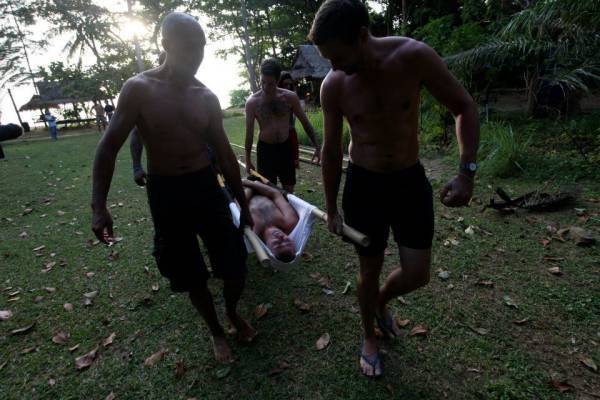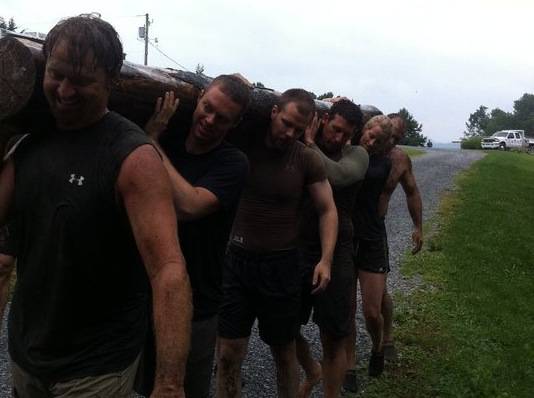We were only two days into our fitness retreat and a fellow participant, “Frank,” was already in a legitimate life-or-death struggle. A seemingly non-stop series of head-high waves were breaking right on top of him while a powerful undertow, typical of Mexico’s Riviera Nayarit coastline, prevented his return to shore.
This wasn’t some sadistic “natural movement” challenge, though, as our evening session of MovNat practice with Erwan Le Corre was already complete. Most of our group members were engaged in euphoric post-workout chatter and had already begun preparing for the mile-long hike back to the surf village of Sayulita.
Frank was near drowning, in a sick twist of irony, just after sharpening his ability to become stronger, tougher, and more self-reliant. Watching his struggle from the shore, I stood dumbfounded and unsure if my new friend needed help or not, while his ability to save his own life was being put to the ultimate test.
By circumstances of pure fate, two of the many paradigm-shifting lessons taught by Erwan quickly became critical to Frank in his stark confrontation with real world danger. As push transitioned to shove, would he display the crucial combination of skill, strength, and stamina required to save his own skin?
Lesson #1 – Practical Skills Require Specific Training
In the fitness industry, we’ve become increasingly reliant on the concept that getting stronger and more conditioned in fundamental human movement patterns fully prepares us to be “ready for anything.” We assume that by having the muscular power, mobility, and perfectly timed fine motor control required to snatch a loaded barbell overhead, plus the energy system efficiency required to earn a respectable “Cindy” or one-mile time, we have developed all the physical assets we could possibly need to fare well in a situation like Frank’s.
But are we truly empowering ourselves to have a sufficient degree of useful physical competence? Or are we getting stuck fixating our valuable training time grinding toward an arbitrary set of synthetic skills, such as lifting perfectly balanced barbells, climbing on powder-coated steel bars, and running on unnaturally level surfaces?
“The fitness industry’s status quo has largely become a potent narcissistic reagent, strongly paralleling the at-all-costs competitiveness that has run amuck in our culture.”
Undoubtedly, Frank’s level of general strength and conditioning certainly contributed, at least to some degree, to his ability to handle the situation. But should his ability to survive hinge on skills only mildly relevant to the all-or-none type of situation at hand or would more specific training have served him better?
We know the answer, largely because of two ubiquitous scientific principles:
- SAID (specific adaptation to imposed demands) – Preparing for a survival situation involving swimming by practicing squatting, hinging, pushing, pulling, rowing, and sprinting is the equivalent of perfecting your algebra to prepare your business for tax season – valuable, but excessively nonspecific. According to this principle, in order to overcome the high level of imposed demands, Frank needed to have earned the specific adaptation through his training. Not only physical adaptations, but also behavioral adaptations because equally important to his physical prowess was his situational intelligence. He needed to know how to best apply his skills – when to swim hard versus when to relax and conserve his precious energy stores.
- Synergy – In our modern training programs, we’ve compartmentalized our fitness routines. Leg day. Back day. Strength day. HIIT day. Rest day. We’ve reduced our movements down to their rawest kinesthetic components and functions. We’ve designed our programs and “periodized” them to elicit peak competition day performance and picture perfect leanness. But we’ve forgotten to reassemble the whole complicated mess back into something more complete than calorie burning, squat strength, and energy systems development in order to better serve the average citizen who pursues physical health and fitness. The vast majority of people will, at some point, find themselves in the most ancient of human circumstances – the kind of crucial situations that require a truly holistic skill set. And in the same way that an athletic competition requires extensive training in that specific sport to develop an integrated, effective skill set, so does life. Let’s not forget that.
Unfortunately, Frank didn’t possess the skill set he needed to overcome that particular situation, literally leaving his fate to the tides.

Putting the “strong to be helpful” concept to work at a MovNat retreat in Thailand
Lesson #2 – Fitness Has a Greater Purpose
As a lifelong athlete and strength addict, I’ve become all too aware of the biggest motivation behind my training – winning. I want to stand out, be exceptional at whatever I do, and hopefully present myself as humble enough to be an inspiration for others to follow in my footsteps.
But in order for me to win, by definition, many others need to lose. While winning has its place in life, should it be the dominant ingredient that drives our health and fitness efforts? The fitness industry’s status quo has largely become a potent narcissistic reagent, strongly paralleling the at-all-costs competitiveness that has run amuck in our culture.
“Deep down, I believe we all are craving more substance from our fitness, so we can make our pursuits of health, confidence, and self-actualization become something immensely gratifying.”
Walk into any gym and you can feel it. The gym scene has become grounds for an ongoing superficial size-up, rivaling that of a fifth grade playground sprint contest. Call it “gymtimidation” or whatever you want, but it’s real. And it’s left a great many sitting at the sidelines, wondering if it’s really worth the cost of admission into yet another high-pressured rat race.
Deep down, I believe we all are craving more substance from our fitness, so we can make our pursuits of health, confidence, and self-actualization become something immensely gratifying. I found that substance on the Sayulita shoreline, as Erwan Le Corre hoisted Frank out of the surf. “Don’t wait until your brother is in obvious distress. Go find out,” Erwan said. “Become strong to be helpful, because attempting to assist without the required skill is useless and sometimes even counter-productive,” he continued, as the house of cards that was my “elite fitness” alter ego became shaken at its foundation.
At that moment of epiphany, I felt an electrical storm of neurons realigning themselves as I realized I had been shown the link between fitness and the humility that accompanies a purpose bigger than one’s self.

MovNat workshops and certifications focus on cooperation and practical exercises.
Shift Your Perspective
Back home, I still reflect on the fact that Frank could have easily been my father, my wife, my son, you, or even myself. I take great comfort that people like Erwan exist, because the practice of natural movement is capable of causing a much needed, fundamental shift in collective mindset – a “movement movement” that could make our world a much richer place.
“There’s something incredibly satisfying about imparting a ‘strong to be helpful’ message to others, especially our more impressionable youth.”
I find myself itching for my workout sessions again. While I don’t have the ability to train for every possible survival situation, my training now better emulates the types of higher-level tasks our bodies were designed to complete. As I develop skills like pop ups, rolling, balancing, crawling, and barefoot running, I enjoy a child-like curiosity and freedom during my workouts. A smile has replaced my killer-instinct scowl as I’ve found a purpose that fosters powerful, deeply motivating internal dialogue. I feel my body becoming more able and timelessly athletic looking – assets I am, naturally, embracing with open arms.
As a gym owner and personal mentor, I have had the opportunity to work with people of all walks of life. There’s something incredibly satisfying about imparting a “strong to be helpful” message to others, especially our more impressionable youth. I hope you, too, will find MovNat’s philosophy and exercise modalities infectious so you can accompany me down this newfound journey.
More Like This:
- Move Your Body, Move Your Brain: Training for Neuroplasticity
- Understanding and Analyzing Your Movement Environment
- Fit for Duty: The Fitness of Fire Fighting
- New on Pulse Beat Fit Today
Photo 1 courtesy of Shutterstock.
Photo, 2 and 3 courtesy of MovNat.






